Granite vs stone cookware is a common kitchen confusion. For the home cook, “granite” cookware usually means a durable, non-stick coating reinforced with mineral particles, while “stone” cookware often refers to true soapstone or ceramic coatings, offering excellent heat retention. Choosing the best buy depends on your cooking style, budget, and durability needs.
Are you staring at two shiny new pots and feeling a little lost? You see “granite” on one box and maybe “stone-derived” on another, and you wonder if they are the same thing. It’s easy to feel confused! Buying cookware should be exciting, not stressful. The good news is that understanding the small differences helps you pick the perfect set that lasts for years.
We are going to cut through the marketing noise. We’ll explain exactly what these terms mean in the kitchen appliance world, how they perform on your stove, and how to spot the very best deals for your cooking needs. Get ready to feel confident about your next kitchen purchase!
Understanding the Hype: What is “Granite Cookware,” Really?
When most people talk about “granite cookware,” they are not usually talking about pots made from actual, solid slabs of granite rock. That would be incredibly heavy and impractical for everyday use! Instead, this term refers to a specific type of modern non-stick coating.
The Science Behind the “Granite” Name
This popular cookware style utilizes a multi-layer, often ceramic-based, non-stick coating. The key feature is that manufacturers infuse this coating with tiny, hard mineral particles—sometimes small specks of actual granite or another very hard stone composite.
- Purpose of the Particles: The goal is to make the non-stick surface tougher. These added particles act like microscopic armor, increasing scratch resistance compared to older Teflon coatings.
- Base Material: Underneath this coating, the pan body is usually made of durable aluminum. Aluminum heats up very quickly and evenly, making it a great conductor of heat.
- Safety Note: Modern granite coatings are generally considered safe and are usually PFOA and PTFE-free, which is great news for home cooks concerned about traditional non-stick chemicals. You can check sources like the U.S. Food and Drug Administration (FDA) for general cookware safety guidelines.
Pros and Cons of Granite Cookware
Like any tool in your kitchen arsenal, granite-style pans have their strengths and weaknesses. Knowing these helps you decide if this style fits your routine.
Benefits (Pros):
- Excellent Non-Stick Release: Food slides right off, reducing the need for large amounts of oil or butter.
- Faster Heating: Because they are typically built on an aluminum core, they heat up fast—perfect for quick weeknight meals.
- Lightweight: Compared to cast iron or true stone, these are often very easy to lift and maneuver, even when full.
- Easy Cleanup: Often dishwasher safe (though handwashing is usually recommended to prolong life).
Drawbacks (Cons):
- Durability Limits: While tougher than basic non-stick, the coating will eventually wear down over years of heavy use, especially if you use metal utensils.
- Lower Maximum Heat: High heat can degrade the non-stick properties faster, so they are best for low-to-medium cooking.
- Repair Costs: Once the coating fails, you must replace the entire pan, unlike cast iron which can be re-seasoned.

Exploring True Stone Cookware: Soapstone and Ceramic Options
When we talk about true “stone cookware,” we step away from the modern aluminum pans and often enter the realm of historic, heavy-duty materials. There are two main types you might encounter: soapstone and ceramic (which sometimes overlaps with the “granite” look but has different core properties).
Soapstone Cookware: The Old School Heavyweight
Soapstone is a natural metamorphic rock. It has been used for centuries for baking and cooking because of its incredible ability to hold heat.
If you see a pot labeled simply as “stone,” especially if it feels surprisingly heavy and dark grey or black, it might be soapstone. It requires a bit more care upfront, but rewards you with amazing heat retention.
Key Features of Soapstone:
- Heat Retention: This is its superpower. Once hot, soapstone stays hot for a very long time, making it ideal for slow-cooked stews or keeping food warm on the table.
- Seasoning Required: Like cast iron, soapstone often needs to be “seasoned” with mineral oil before its first use to seal the pores and achieve a dark, beautiful finish.
- Natural Material: It is completely natural, non-reactive, and incredibly durable. It won’t chip like an enamel coating can.
Ceramic Coatings (Often Mislabelled as Stone/Granite)
It is crucial to note that many products sold as “granite” or “stone” are actually using a very strong, durable ceramic non-stick coating built on an aluminum base. True ceramic coatings are typically made from silicone-based materials (silica) fired at high temperatures. They provide a rock-hard surface that is highly resistant to scratching and leaching.
Granite Vs Stone Cookware: Head-to-Head Comparison
To make the best decision, let’s place these two categories side-by-side. Think of this table as your quick-reference guide for your next shopping trip.
| Feature | “Granite” Cookware (Mineral-Reinforced Non-Stick) | True Stone Cookware (e.g., Soapstone) |
|---|---|---|
| Core Material | Aluminum (Lightweight) | Natural Stone (Very Heavy) |
| Heat Response | Very Fast Heating; Medium Heat Retention | Slow to Heat Up; Exceptional Heat Retention |
| Non-Stick Quality | Excellent initially, wears down over time | Requires oil/fat, but food rarely sticks if seasoned properly |
| Oven Safety | Varies, usually safe up to 400°F – 500°F (Check manufacturer) | Extremely high heat tolerance |
| Maintenance | Easy cleanup; avoid metal utensils | Requires initial seasoning; can be scrubbed harder |
| Durability Focus | Coating longevity | Lifetime physical material durability |
Choosing the Right Cookware for Your Kitchen Style
The “best buy” isn’t about which one is objectively superior; it’s about which one matches how you cook. Let’s explore a few common kitchen profiles.
Profile 1: The Quick Meal Cook (Best for Granite)
If your priority is getting dinner on the table fast, using minimal oil, and being able to toss a pan in the dishwasher after a scramble, granite fits you perfectly.
- You need fast preheating for searing morning eggs or quick sautéing.
- You value ease of use and cleaning above heirloom quality.
- You prefer light, easy-to-handle pots and pans.
Profile 2: The Slow Cook & Baker (Best for Stone/Soapstone)
If you love simmering sauces for hours, baking bread, or serving a dish directly from the cooking vessel to keep it piping hot, true stone is your champion.
- You don’t mind pans taking extra time to heat up.
- You want to avoid any synthetic coatings for preference or health reasons.
- You are looking for a piece of cookware that can truly last multiple generations.
For deeper maintenance tips on natural materials, looking at established culinary resources can provide great context. For instance, soapstone care often mirrors cast iron care in terms of surface treatment, as noted by many cooking experts who focus on material longevity.
Beginner’s Guide: Essential Buying Tips for Granite Cookware
Since granite-style cookware is currently the most popular choice for its non-stick properties, here is what you need to look for when shopping to ensure you get a quality product that won’t disappoint after just a few months.
Step 1: Inspect the Base Material
The aluminum core dictates performance. Look for heavy-duty construction. Lighter pans often use thinner aluminum, leading to hot spots where food burns unevenly.
- Look for: A thick base (often 3mm or more).
- Avoid: Pans that feel extremely light for their size, as they usually have thinner walls.
Step 2: Check the Number of Layers
A higher layer count usually means better durability. Manufacturers often boast about 3-layer, 5-layer, or even 8-layer systems, blending the ceramic base with the mineral reinforcement.
Tip: Don’t just count the layers on the inside surface; look for a fully clad body if possible, though most granite cookware focuses the layers on the cooking surface.
Step 3: Examine the Handles and Construction
Handles are a common failure point. If the handles are riveted (bolted directly to the pan), they are much more secure than handles that look glued on or screwed in cheaply. Check the oven-safe temperature rating on the packaging.
Step 4: Read Real User Reviews Focused on Longevity
The best way to test long-term performance is through other users. Search reviews specifically mentioning what the pan looked like after 6 months or a year of regular use. If many people complain about the coating failing quickly, steer clear.
Essential Best Buys: Top Picks for Granite Cookware
While I can’t recommend specific store brands, I can give you the characteristics that define the current “best buys” you should look for when browsing your local appliance store or online retailer. These brands typically excel in the areas we discussed.
| Best Buy Characteristic | Why It Matters | What to Look For on the Aisle |
|---|---|---|
| Heavy-Gauge Aluminum Base | Ensures even heat distribution and prevents warping. | Weight of the pan in hand; look for ‘Clad base’ descriptions. |
| PTFE/PFOA Free Certification | Addresses health concerns regarding traditional non-stick chemicals. | Clear labeling showing “Free from,” or certifications listed on the box. |
| Reinforced (Visible Flecks) | Indicates the mineral strengthening in the coating. | A speckled, slightly textured appearance on the interior surface. |
| Induction Ready (If Applicable) | Essential if you have an induction stovetop (requires a magnetic stainless steel plate on the bottom). | Look for the coiled ‘induction’ symbol on the pan bottom. |
Maintaining Your New Cookware for Maximum Lifespan
Whether you chose the speedy granite style or the thermal champion stone, maintenance is what unlocks longevity. Think of it like preventative fluid changes for your car—a little care now saves big headaches later!
Caring for Granite/Ceramic Non-Stick Surfaces
The surface is its weak point, so treating it gently is key to keeping that essential non-stick capability active.
- Hand Wash Only: Even if the box says it’s dishwasher safe, the harsh detergents and high heat of a dishwasher will break down the non-stick coating much faster than simple handwashing. Use a soft sponge, not steel wool.
- Avoid Thermal Shock: Never take a screaming hot pan and plunge it into cold sink water. This rapid temperature change can cause the base to warp and the coating to degrade prematurely. Let it cool down gradually on the stovetop first.
- Use the Right Tools: Stick to wooden, plastic, or silicone spatulas and spoons. Metal utensils are the number one enemy of these coatings.
- Gentle Cooking: Reserve your granite pans for low to medium heat cooking. High heat degrades the non-stick bond faster than anything else.
Caring for True Soapstone Cookware
If you invested in real soapstone, your approach needs to be different. It’s about maintenance, not perfection.
- Re-seasoning: If the stone starts looking dull or food begins to stick slightly, it simply needs more oil. Wipe the stone down with a thin coat of food-grade mineral oil (like you use for cutting boards) and heat it gently to let the oil soak in.
- Scrubbing Ability: Unlike granite cookware, soapstone can handle a stiff brush or even a light scrub pad if something stubborn gets stuck. It’s very forgiving physically.
- Thermal Patience: Always preheat soapstone slowly. Put the pan on the lowest heat setting for 10–15 minutes before gradually increasing the temperature. This ensures the entire stone body heats evenly.
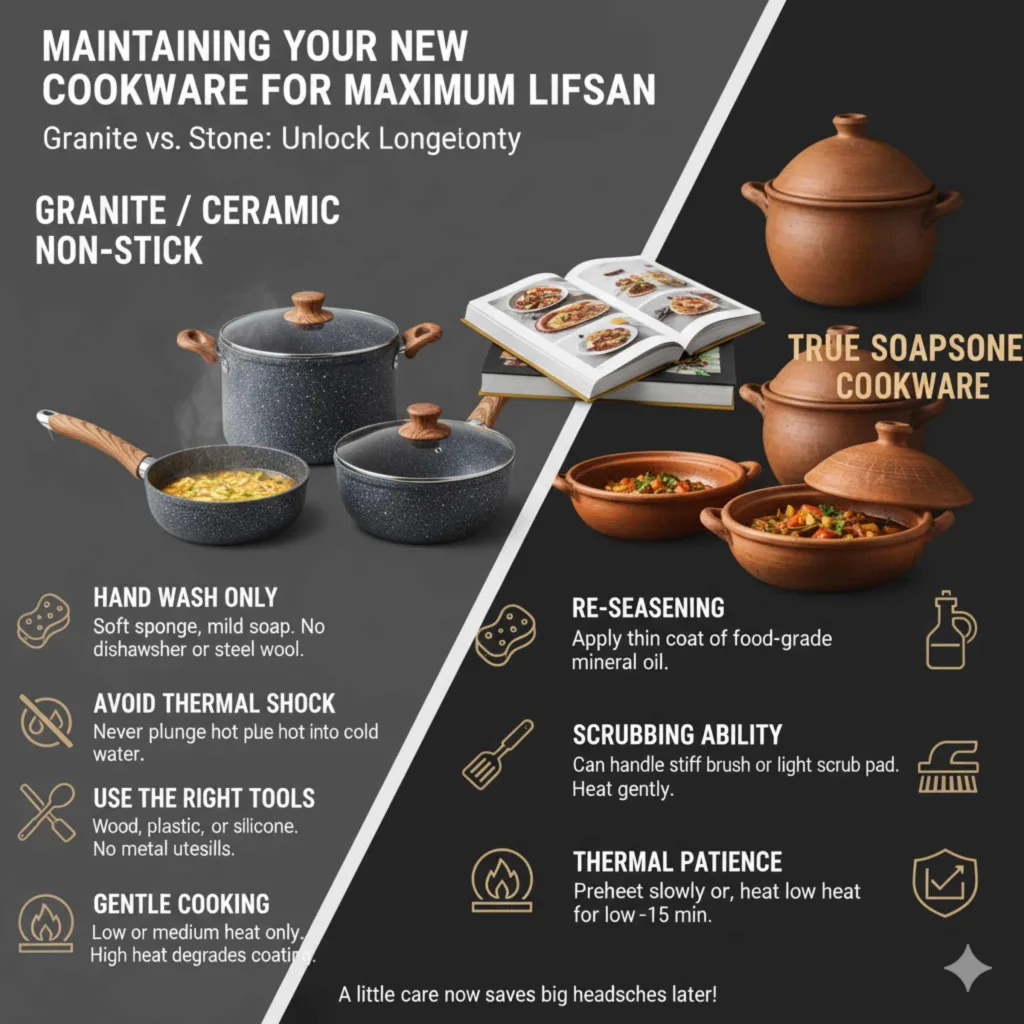
FAQs for the Beginner Cookware Buyer
Q1: Is “Granite Cookware” actually made of granite?
A: No, typically not. It refers to a durable, multi-layer non-stick coating reinforced with hard mineral particles (like flecks of quartz or granite composite) set over an aluminum base. It provides great non-stick performance.
Q2: Which heats up faster, granite-style or true soapstone cookware?
A: Granite-style pans, due to their aluminum core, heat up very quickly. True soapstone heats up slowly because dense stone requires more time to absorb and distribute heat evenly.
Q3: Can I ruin my granite pan by going from the stove to the oven?
A: You might, if you exceed the temperature limit. Always check the manufacturer’s maximum oven-safe temperature (usually between 400°F and 500°F). Going hotter can damage the non-stick layer.
Q4: If I scratch my granite pan, should I throw it away?
A: A tiny scratch might not be an immediate disaster, but if you see large patches of the coating flaking off or the actual metal underneath starting to show frequently, it’s time to retire the pan. Scratches compromise the non-stick layer and can expose the base metal to wear.
Q5: Is stone cookware safe to use on an induction cooktop?
A: True soapstone is not magnetic and will not work on induction unless it has a stainless steel induction plate fused to the very bottom. Granite-style aluminum pans usually only work on induction if they are clad with a magnetic stainless steel base layer.
Q6: Which option is better for learning to cook without too much oil?
A: For ease of use and immediate non-stick results with little oil, the mineral-reinforced “granite” style is usually the best starting point for beginners.
Conclusion: Driving Your Decision Home
Deciding between granite-style and true stone cookware boils down to understanding performance versus preparation. You are choosing between speed and temperature endurance.
The modern, mineral-reinforced granite cookware offers a fantastic, lightweight package that heats fast and cleans up easily—perfect for the busy everyday driver in the kitchen. It promises non-stick performance right out of the box, requiring minimal fuss.
On the flip side, if you are ready to invest a little time in initial seasoning and need cookware that will maintain a steady, powerful heat for the long haul, a true stone piece is an heirloom choice offering superior heat retention. Remember the keys: for granite, protect the coating; for stone, respect the slow heat-up time.
By keeping these core differences in mind—the aluminum core of granite vs. the thermal mass of stone—you now have the knowledge to select the cookware that fits your driving style in the kitchen. Happy cooking!

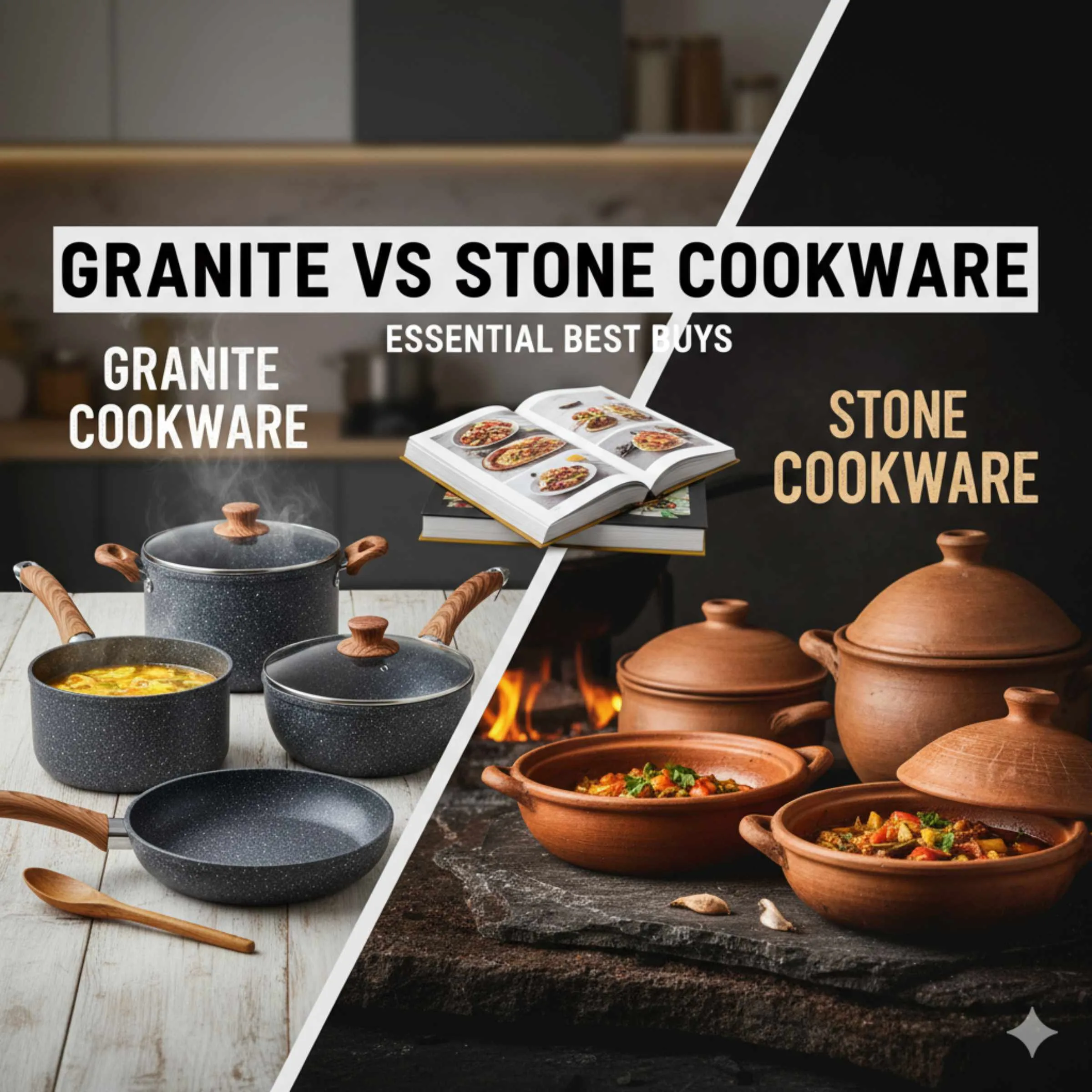
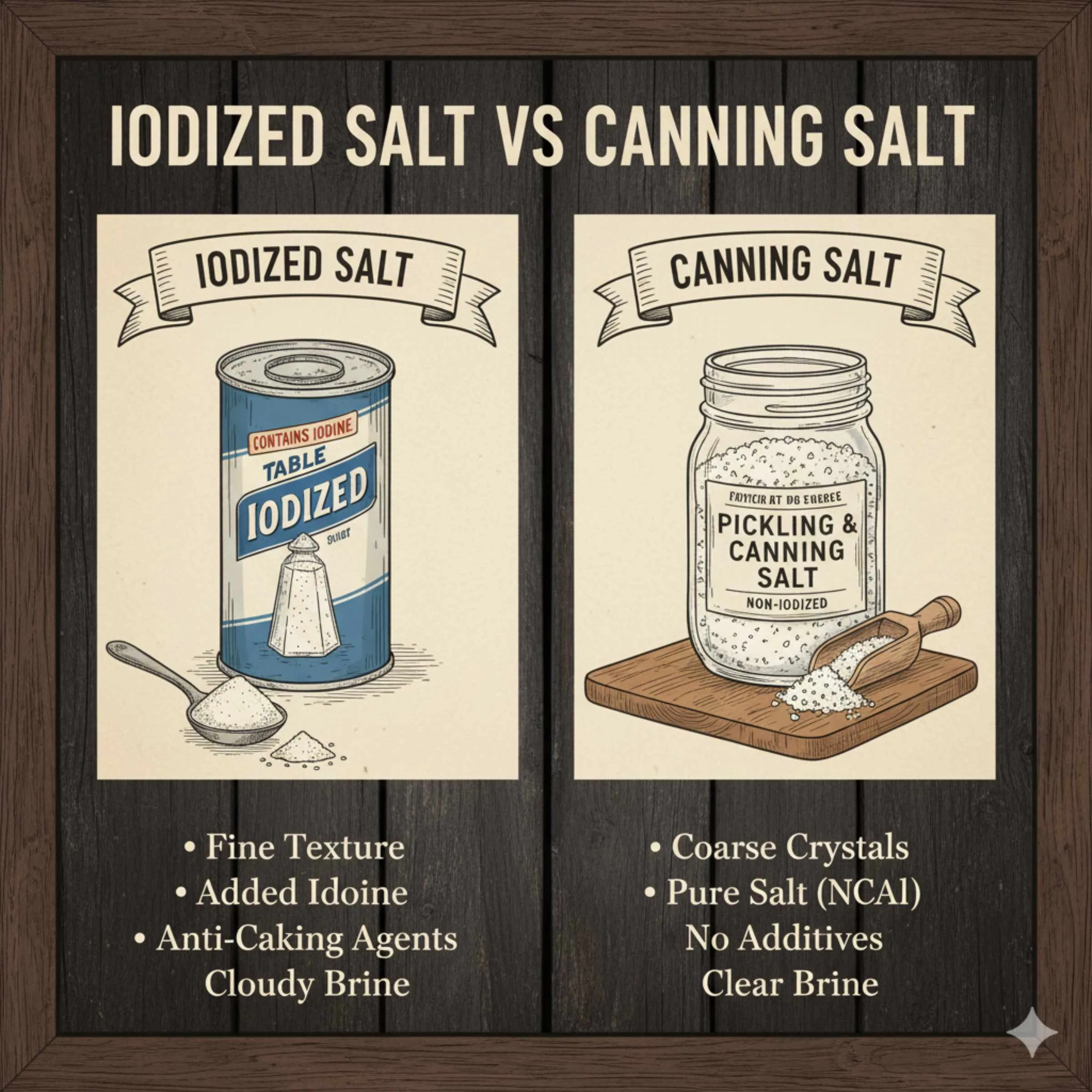
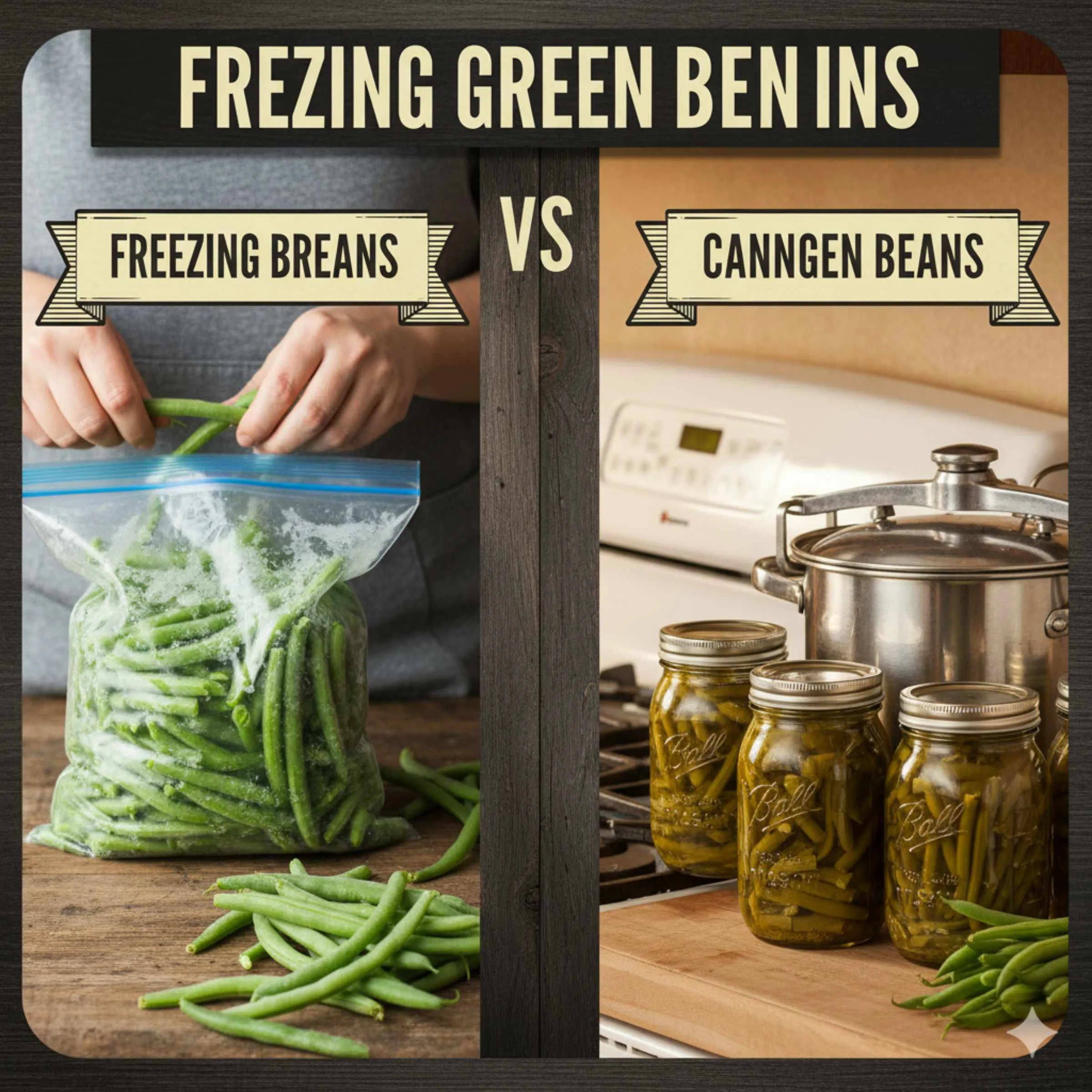


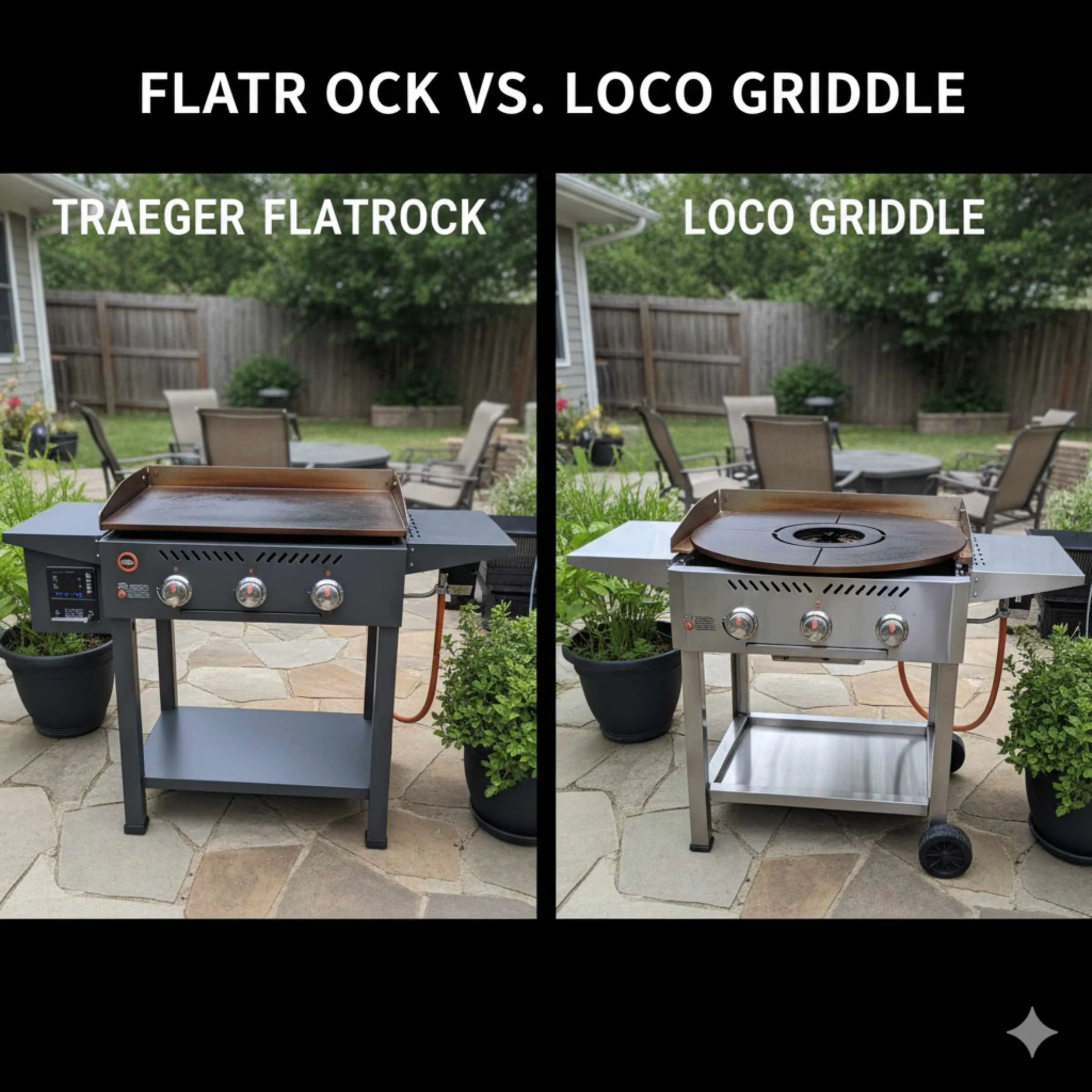

Leave a Reply